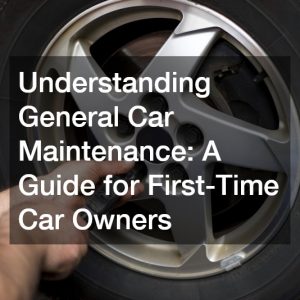Owning a car comes with significant responsibilities, not just around usage but also around maintenance. However, many car owners may find themselves in situations where their car is not driven for extended periods. Whether it’s due to a prolonged vacation, a shift to remote work, or other lifestyle changes, leaving your vehicle idle can have various unforeseen consequences. This article aims to delve into the numerous issues that can arise when a car sits unused and why it’s essential to remain vigilant with car maintenance, even when the vehicle is not in active use.
While it may seem that a car parked safely in your garage or driveway is free from harm, that’s not necessarily the case. From uninvited animal guests making your vehicle their home to the gradual degradation of essential auto parts, a car that has not been driven can face multiple challenges. To keep your car in optimal condition, understanding these potential issues can be the first step in preventive care. We will explore the impact on various auto parts, the importance of regular auto inspections, and the risks to both the car’s exterior and interior. Additionally, we’ll look into how these factors can affect your vehicle’s overall worth.
If you’ve been thinking about taking your car for a spin or considering its long-term storage needs, this comprehensive guide will be invaluable. We’ll cover each topic in detail, offering actionable advice for ensuring your vehicle remains functional and valuable, even when it’s not hitting the road regularly. So, buckle up and read on to learn what happens when your car is not driven for a while.
How Animals Can Make Your Car Their Home

When a car is not driven for an extended period, it’s not just mechanical issues you need to worry about. One often overlooked problem is the possibility of animals making your car their home. Small creatures like rodents, birds, and even reptiles can find their way into your vehicle, causing significant damage. They are attracted to the warmth and shelter that an unused car provides, making nests in the engine bay or other interior spaces.
Animal removal can become a necessary task if these invaders take up residence. Rodents, in particular, can be problematic as they tend to chew through wires, insulation, and other auto parts. The damage caused by their activities can lead to costly repairs, making it essential to regularly check your vehicle even when it’s not being driven. Clearing out nests, droppings, and inspecting for chewed wires can go a long way in preventing long-term damage.
To mitigate the risk of animals taking over, it’s wise to take preventive measures. Using deterrents like mothballs, peppermint oil, or even installing mechanical traps around the car can be effective. Ensuring that you drive the car periodically, if only for a short distance, can also discourage animals from settling in. Regular inspections can help catch the problem early, making it easier and cheaper to handle.
The Impact of Long-Term Inactivity on Auto Parts

A car that is not driven for long periods will inevitably face issues with various auto parts. The battery is one of the first components to suffer, as it can lose its charge when not in use. Modern vehicles rely heavily on electronics, and a dead battery can lead to multiple problems, from immobilizing the car to resetting critical systems.
Tires can also degrade if the car is not driven for a while. Flat spots can develop where the rubber meets the ground, affecting the overall ride quality and safety of the vehicle. The lack of motion causes the tires to settle, making them more susceptible to deflation and degradation. Regularly checking tire pressure and moving the car slightly can help in avoiding these issues.
Fluids like engine oil, transmission fluid, and brake fluid can also deteriorate when the car is not in use. These fluids undergo chemical changes over time, losing their effectiveness. This can lead to problems when you eventually start the car, making the necessity for fluid checks and changes critical, even if the car sits idle.
Why Regular Auto Inspections Are Crucial for Cars That Sit Idle

Regular auto inspections become even more crucial for vehicles that are not driven regularly. When a car sits idle for long periods, unseen problems can develop, making it essential to keep up with routine check-ups. Inspections help identify and rectify issues before they escalate, ensuring the car remains in good condition.
Auto inspections can detect problems with auto parts that you may not be aware of. For instance, the state of the battery, the condition of the tires, and the levels of essential fluids can all be assessed during an inspection. These inspections can help keep the car ready for use, ensuring that it’s in good working condition when you need it.
Scheduling routine auto inspections can save you money in the long run. By catching small issues early, you can avoid costly repairs and prolong the life of your vehicle. Regular maintenance becomes even more critical when the car is not driven, making these inspections a valuable investment.
What Can Happen to the Exterior

When a car is not driven for a while, the exterior can suffer as well. Dust, dirt, and bird droppings can accumulate, leading to corrosion and paint damage. Auto detailing can help preserve the car’s appearance and protect it from these issues. Regular cleaning, even when the car is not being used, is essential to maintain its exterior.
Additionally, exposure to the elements can cause fading and oxidation, especially if the car is parked outdoors. Protective measures like using a car cover or parking in a shaded area can help reduce this damage. Auto detailing can also include treatments that protect the paint, making it more resilient to these environmental factors.
Rust can become a significant problem for a car that is not driven. Moisture can accumulate on the car’s surface, leading to rust spots and weakened structural integrity. Regular washing and waxing can help mitigate this risk, keeping the car’s exterior in good shape even when it’s not being driven.
The Degradation of Inactive Car Parts
In addition to the battery and tires, other crucial auto parts can degrade when the car is not driven. The brake system is one such component that can suffer from inactivity. Local brake repair services often see cars come in with rusted or seized brakes due to long periods of disuse. This can lead to decreased braking efficiency and even safety hazards.
Another issue is the degradation of rubber components like belts and hoses. These parts can dry out and crack when not in use, leading to potential leaks and mechanical failures. Regular inspections can help identify these issues early, ensuring that the car remains in good working order.
Modern cars also rely on complex electronic systems that can suffer from inactivity. Sensors, control units, and other electronic components can malfunction when not regularly used. Running engine diagnostics periodically can help identify any electronic issues, allowing for timely repairs and maintenance.
The Risk of Auto Body Damage in Unused Cars
A car that is not driven is not immune to auto body damage. Parking the car in one spot for a prolonged period can result in minor dents and scratches that go unnoticed. Auto dent repairs can become necessary to maintain the car’s appearance and structural integrity.
External factors like falling branches, hail, and even other vehicles can cause damage to a parked car. Regular inspections and choosing a safe parking location can minimize these risks. Even minor damage can lead to more significant problems if left unattended, making timely repairs essential.
Preventative measures like using a car cover can also protect the exterior from unforeseen damage. Regularly moving the car to different parking spots can help distribute environmental exposure, reducing the likelihood of auto body damage. Staying proactive about these risks can save you money and stress in the long run.
What Can Happen to Your Glass When the Car Stays Parked
Your car’s glass components, including windows and the windshield, can also suffer when the car is not driven for a while. Exposure to the elements can cause the glass to weaken or even crack. Windshield replacements can become necessary if severe damage occurs, which can be costly.
Temperature fluctuations can also affect the integrity of the glass. In cold weather, moisture can freeze in the tiny cracks, causing them to expand. Conversely, high temperatures can exacerbate existing damage, making it essential to regularly inspect the glass and address any issues promptly.
Dirt and debris can accumulate on the glass, leading to scratches and reduced visibility. Regular cleaning is crucial to prevent these problems. Using appropriate glass cleaners and maintaining the wipers can help keep the windshield and windows in good condition, even when the car is not being driven.
Tire Repair Needs for Cars That Aren’t Driven
Tires are among the most affected auto parts when a car is not driven. Prolonged inactivity can lead to various issues, including flat spots, deflation, and even dry rot. Local tire repairs often have to address these problems, which can otherwise compromise the vehicle’s safety and performance.
As tires sit in one position, flat spots can develop, affecting the overall ride quality. Regularly moving the car or using tire cradles can help prevent this issue. Maintaining proper tire pressure is also essential, even if the car is not in regular use. Periodic checks can ensure the tires are in good condition.
Additionally, UV exposure can degrade the rubber, leading to cracks and weakening the tires. Storing the car in a shaded area or using tire covers can help mitigate this risk. Regular inspections and timely repairs are crucial for maintaining tire integrity and ensuring the vehicle’s safety.
Engine Diagnostics for Cars That Haven’t Moved
Even when a car is not driven, its engine can develop issues that require attention. Engine diagnostics can help identify potential problems before they escalate. Issues like oil degradation, coolant leaks, and sensor malfunctions can be detected early, allowing for timely repairs.
Running the engine periodically, even for a few minutes, can help keep the components lubricated and prevent parts from seizing up. This simple step can go a long way in preserving the engine’s health. Regular engine diagnostics can ensure that the car remains in good working order, even when it’s not being driven.
Neglecting the engine can lead to costly repairs down the line. Sensors, spark plugs, and other engine components can degrade over time, affecting the car’s performance. Engine diagnostics can help detect these issues early, allowing for preventive maintenance and reducing the risk of more significant problems.
Evaluating Your Car’s Worth
When a car is not driven for an extended period, its value can depreciate more rapidly than expected. Local junk car buyers often evaluate vehicles based on their condition and usability. A car that has suffered from prolonged inactivity may fetch a lower price due to the potential issues it may have.
Regular maintenance and inspections can help maintain the car’s value. Keeping the car in good condition, even when it’s not being driven, can make it more appealing to buyers. Addressing minor issues promptly can prevent them from turning into significant problems, preserving the car’s worth.
If you’re considering selling a car that has not been driven for a while, getting it inspected and repaired can increase its value. Local junk car buyers are more likely to offer a better price for a well-maintained vehicle. Evaluating your car’s worth regularly can also help you decide whether it’s more cost-effective to sell or continue maintaining it.
Conclusion
Leaving a car not driven for an extended period can lead to a range of issues, from mechanical problems to exterior damage. Regular maintenance and inspections are crucial to keeping the vehicle in good condition. Addressing small problems promptly can prevent them from escalating, saving you time and money in the long run.
Understanding the potential risks and taking preventive measures can help mitigate the impact of inactivity on your car. From animal removal to auto detailing, and from local brake repair to engine diagnostics, keeping up with essential maintenance tasks can ensure your vehicle remains functional and valuable. The importance of routine inspections cannot be overstated, as they help identify and rectify issues early.
Whether you’re looking to maintain your car for future use or considering selling it, staying proactive about its care is essential. Evaluating your car’s worth and addressing any necessary repairs can increase its value and make it more appealing to buyers. By following the steps outlined in this article, you can keep your car in top shape, even when it’s not being driven.





